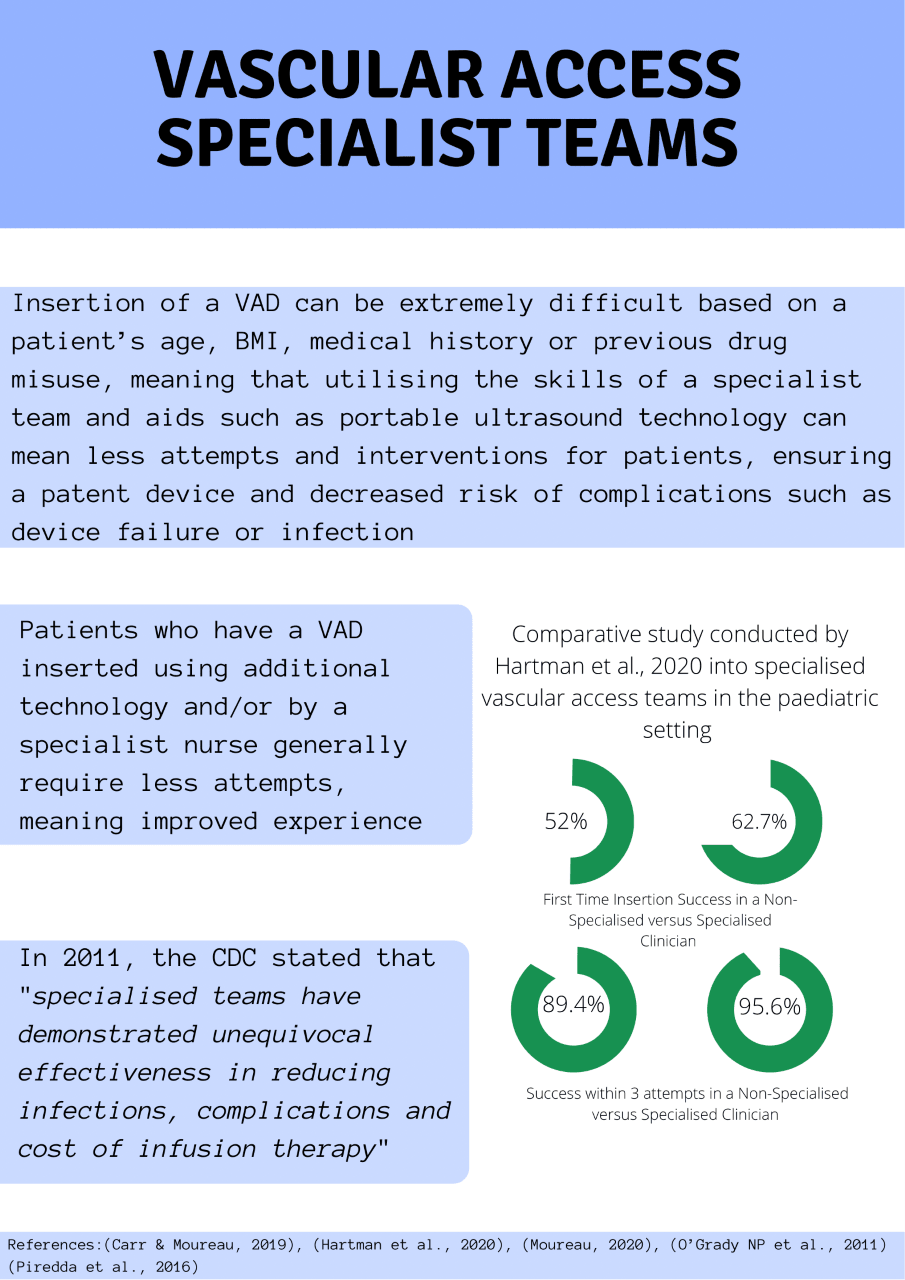Vascular Access Specialist Teams
)
The insertion of a vascular access device (VAD) is one of the most common invasive procedures performed in the hospital setting, however a number of factors across adult and paediatric populations including age, weight extremes, comorbidities, previous difficult intravenous access, and site selection for current VAD can significantly impact overall insertion success and maintenance of a device.1,2
Dedicated vascular access teams are made up of competent clinicians trained to maximise VAD insertion and maintenance success in the acute care setting.3 Through the adoption of a specialised team, hospitals can ensure consistency of VAD insertions, improve patient experience and achieve fewer insertion failures through the use of additional means including ultrasound guided technology.4,5
Given the significant number of factors influencing intravenous access success, it is important that clinicians are able to identify a patient at an increased risk of cannulation difficulty, and assess whether a patient may benefit from the use of specialised expert inserters and additional technologies.6
Technologies such as ultrasound guidance can be used when the patient is recognised as having difficult intravenous access.7 This technology requires additional training, though has proven incredibly beneficial in ensuring correct placement and first-time success of PIVC insertion by up to 50%.8,9
So far, there is limited evidence available to suggest that specialised vascular access teams are superior to generalist clinicians inserting VADs.10 Small single-site studies suggest that when adopting a specialised team, achieving successful access within three attempts increases from 89.4% to 95.6%.6 Furthermore, up to 89% of PIVCs inserted by a specialised team remain in situ until the conclusion of treatment, in the presence of a hospital-wide failure rate of 53%.11
Although the literature is limited, vascular access teams and the skills and resources they provide could contribute significantly to the acute care setting and provide an invaluable service.
References
1. Piredda M, Biagioli V, Barrella B, Carpisassi I, Ghinelli R, Giannarelli D, De Marinis MG. Factors affecting difficult peripheral intravenous cannulation in adults: a prospective observational study. J Clin Nurs 2017;26(7-8):1074-1084.
2. Wallis MC, McGrail M, Webster J, Marsh N, Gowardman J, Playford EG, Rickard CM. Risk factors for peripheral intravenous catheter failure: a multivariate analysis of data from a randomized controlled trial. Infect Control Hosp Epidemiol 2014;35(1):63-68.
3. Marsh N, Larsen E, Webster J, Cooke M, Rickard C. The benefit of a vascular access specialist placing a peripheral intravenous catheter: a narrative review of the literature. Vascular Access 2020;6(1):10-15
4. Carr P, Moureau N. Specialised Vascular Access Teams. In: Springer C, editor. Vessel Health and Prevention: The Right Approach for Vascular Access: Springer, Cham; 2019. p. 59-65.
5. Moureau N. Establishing Vascular Access Teams for Patient Safety. Infection Control Today 2020;24(4).
6. Hartman JH, Bena JF, Morrison SL, Albert NM. Effect of adding a pediatric vascular access team component to a pediatric peripheral vascular access algorithm. J Pediatr Health Care 2020;34(1):4-9
7. Carr P, Higgins N, Cooke M, Mihala G, Rickard C. Vascular access specialist teams for device insertion and prevention of failure. Cochrane Library 2018;3(3):CD011429.
8. Blanco P. Ultrasound-guided vascular cannulation in critical care patients: A practical review. Medicina Intensiva 2016;40(9):560-71.
9. Archer-Jones A, Sweeny A, Schults JA, Rickard CM, Johnson L, Gunter A, Watkins S. Evaluating an ultrasound-guided peripheral intravenous cannulation training program for emergency clinicians: An Australian perspective. Australas Emerg Care 2020;23(3):151-156
10. Davis EM, Feinsmith S, Amick AE, Sell J, McDonald V, Trinquero P, . . . Barsuk JH. Difficult intravenous access in the emergency department: Performance and impact of ultrasound-guided IV insertion performed by nurses. Am J Emerg Med 2021;46:539-544.
11. Steere L, Ficara C, Davis M, Moureau N. Reaching one peripheral intravenous catheter (PIVC) per patient visit with lean multimodal strategy: the PIV5Rights™ bundle. JAVA: Journal of the Association for Vascular Access 2020;24(3):31-43.
Other
O'Grady NP, Alexander M, Burns LA, Dellinger EP, Garland J, O'Heard S, . . . Saint S. Guidelines for the prevention of intravascular catheter-related infections. Clin Infect Dis 2011;52(9):e162-193
| Tags:insertionvascular access devicesspecialist teams |








